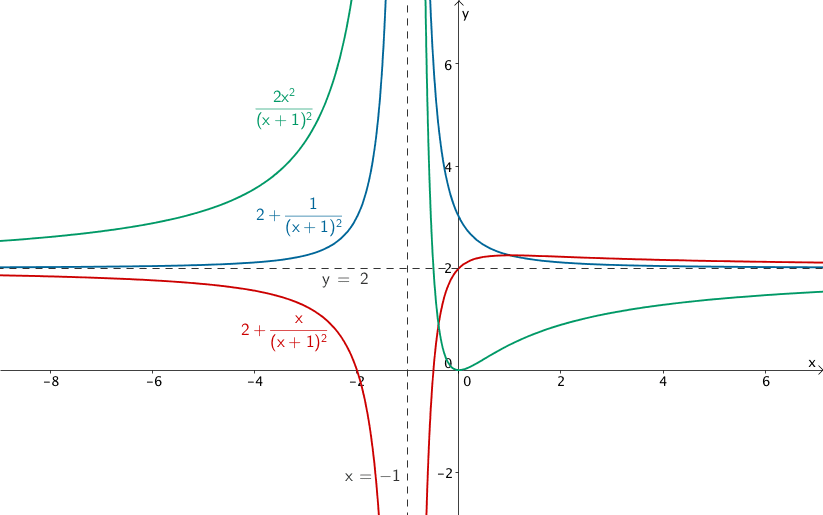Geben Sie den Term einer gebrochen-rationalen Funktion \(f\) mit Definitionsmenge \(\mathbb R \backslash \{-1\}\) an, deren Graph die Gerade mit der Gleichung \(y = 2\) als Asymptote besitzt und in \(x = -1\) eine Polstelle ohne Vorzeichenwechsel hat.
(3 BE)
Lösung zu Teilaufgabe 4
Mögliche Funktionsterme sind z.B.:
\[f(x) = 2 + \frac{1}{(x + 1)^2}\]
oder
\[f(x) = 2 + \frac{x}{(x + 1)^2}\]
oder
\[f(x) = \frac{2x^2}{(x + 1)^2}\]
Vorgehensweise:
1. Bedingung:
\(D_f = \mathbb R \backslash \{-1\}\)
\(x = -1\) ist Polstelle ohne Vorzeichenwechsel
\(\Longrightarrow \quad\) Der Nenner von \(f\) hat für \(x = -1\) eine Nullstelle gerader Ordnung, die nicht gleichzeitig Nullstelle des Zählers ist.
\(\Longrightarrow \quad\) z.B. Nennerterm: \(h(x) = (x + 1)^2\)
2. Bedingung:
\(y = 2\) ist Asymptote
\(\Longrightarrow \quad\) Ansatz: \(f(x) = 2 \pm g(x) \,\), wobei gilt: \(\lim \limits_{x \, \to \, \pm \infty} g(x) = 0\)
\(\Longrightarrow \quad\) z.B. \(\displaystyle f(x) = 2 + \frac{1}{(x + 1)^2}\)
Alternativer Ansatz:
\(f(x) = \frac{p(x)}{q(x)}\), wobei \(p(x)\) und \(q(x)\) Polynome gleichen Grades sind und die Polynomdivision von p(x) durch q(x) den Funktionsterm in die Form \(f(x) = 2 \pm g(x)\) mit \(\lim \limits_{x \, \to \, \pm \infty} g(x) = 0\) überführt.
\(\Longrightarrow \quad\) z.B. \(\displaystyle f(x) = \frac{2x^2}{(x + 1)^2} = 2 - \frac{4x +2}{(x + 1)^2}\)
Beispiele für gebrochen-rationale Funktionen, deren Graph in \(x = -1\) eine Polstelle ohne Vorzeichenwechsel hat, und die waagrechte Asymptote \(y = 2\) besitzt.



